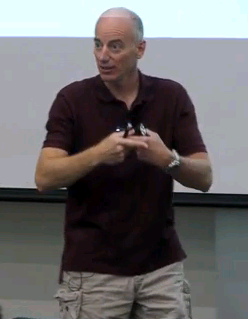UCI Chem 131C Thermodynamics and Chemical Dynamics (Spring 2012)
Lec 23. Thermodynamics and Chemical Dynamics -- Lindemann-Hinshelwood Part I --
View the complete course: ../courses/chem_131c_thermodynamics_and_chemical_dynamics.html
Instructor: Reginald Penner, Ph.D.
License: Creative Commons BY-NC-SA
Terms of Use: ../info.
More courses at http://ocw.uci.edu
Description: In Chemistry 131C, students will study how to calculate macroscopic chemical properties of systems. This course will build on the microscopic understanding (Chemical Physics) to reinforce and expand your understanding of the basic thermo-chemistry concepts from General Chemistry (Physical Chemistry.) We then go on to study how chemical reaction rates are measured and calculated from molecular properties. Topics covered include: Energy, entropy, and the thermodynamic potentials; Chemical equilibrium; and Chemical kinetics.
Thermodynamics and Chemical Dynamics (Chem 131C) is part of OpenChem: ../openchem/
This video is part of a 27-lecture undergraduate-level course titled "Thermodynamics and Chemical Dynamics" taught at UC Irvine by Professor Reginald M. Penner.
Recorded on May 30, 2012
Slide Information
00:06- Lindemann-Hinshelwood
01:22- Announcements
3:19- Today: Steady-State Approximation, Lindemann-Hinshelwood Mechanism
03:46- The Steady-State Approximation
07:58- Graph: Concentration, Time
08:25- Solve the Simplified Equations that Result
09:37- How Does This Compare with the Exact Solution?
10:25- How Well the Steady State Works- Graph of Concentration, Time
11:18- The Steady-State Approximation is Breaking Down
12:30- Example: Apply the Steady-State Approximation to the Following Reaction Mechanism
18:06- Simplifying Further
21:26- Two Limiting Experimentally Observed Rate Laws
24:40- Most Elementary Reactions are Either Unimolecular or Biomolecular
25:44- Biomolecular Reactions Have an Obvious Mechanism in the Gas Phase
26:17- Transition State Graph
26:42- But How Does a Unimolecular Reaction Occur?
27:06- Unomolecular Reactions- Isomerization
27:31- Unimolecular Reacions- Decomposition Reactions
28:05- How Does this Happen? The Lindemann-Hinshelwood Mechanism Provides an Explanation
30:10- Applying the Steady-Sate Approximation to the Lindemann-Hinshelwood Mechanism
31:10- The Strong Collision Assumption
33:35- Can We Apply the Steady-State Approximation to the Mechanism?
34:14- What Does it Predict?
37:26- What Does This Mean Mechanistically?
38:04- The Kinetics of Pressure-Dependent Reactions
41:19- We Can Write the LH Rate in This Form
43:29- Does it Work? Plot
44:09- It Doesn't Work So Well
45:44- Reactions Where a Pre-Equilibrium is Established
47:45- Test the Lindemann-Hinshelwood Mechanism for the Isomerization of Cyclopropane
49:02- The Data is Not Convincing- Plot
50:18- Use the Steady State Approximation Again
Required attribution: Penner, Reginald Thermodynamics and Chemical Dynamics 131C (UCI OpenCourseWare: University of California, Irvine), ../courses/chem_131c_thermodynamics_and_chemical_dynamics.html. [Access date]. License: Creative Commons Attribution-ShareAlike 3.0 United States License.


